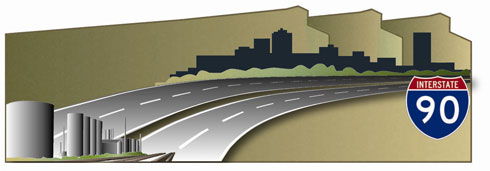
Study Focus
Interstate 90 (I-90) is part of the National Highway System and serves as a primary means of moving people, goods, and services throughout the country. The system is characterized by controlled access, high traffic volumes, and long-distance trips. I-90 serves as the principal east-west route in the Billings area.
The Montana Department of Transportation (MDT), in cooperation with the City of Billings, Yellowstone County and the Federal Highway Administration, (FHWA), initiated the Billings Area I-90 Corridor Planning Study to assess approximately 22 miles of Interstate 90 (I-90) beginning at the Laurel Interchange (Reference Post [RP] 433.8) and ending immediately west of the Pinehills Interchange (RP 455.85). The study completed in March 2012.
Final Study Report
Document (w/o appendices)
Appendix A: Community and Agency Participation Materials
Appendix B: Existing and Projected Conditions Report
Appendix C: Environmental Scan
Appendix D: Improvement Options Report
The Billings Area I-90 Corridor Planning Study examined the geometric characteristics, crash history, and existing and projected operational characteristics of I-90 mainline segments and interchanges, as well as existing and projected physical constraints, land uses, and environmental resources within the corridor study area. The end result of the planning effort is a comprehensive package of short-term and long-term recommendations intended to address the needs and objectives on the I-90 corridor over the planning horizon (2035). These recommendations will assist MDT in identifying potential projects based on needs, objectives, and funding availability.
The Billings Area I-90 Corridor Planning Study included an assessment of eight mainline Interstate segments and eight interchanges, as illustrated in the Study Area.
The Consultant followed the Montana Business Process to Link Planning Studies and NEPA/MEPA Reviews, which requires extensive community involvement and coordination with other partnering agencies.
Issues addressed within the corridor included but were not limited to:
- Interchange and Mainline Interstate Operations
- Interchange and Mainline Interstate Geometric Characteristics
- Bridges and Crossing Structures
- Right-of-Way Constraints
- Existing and Projected Land Use and Development
- Safety
- Environmental Constraints
Previous and Ongoing Planning Efforts
Billings I-90 Interchanges Project (2006)
In 2006, MDT concluded a study that assessed existing and future operational, safety, and capacity needs at five Interstate interchanges in the Billings area. This analysis was used to identify deficiencies, evaluate alternative solutions, and develop a prioritized list of recommended projects. The 2006 study focused on operations at the Shiloh, South Billings Boulevard, 27th Street, Lockwood, and Johnson Lane Interchanges and did not include an evaluation of mainline Interstate operations.
Under the Billings Area I-90 Corridor Planning Study, assessment of interchanges previously studied in 2006 will be limited to review of the portion of the interchange ramps immediately before and after the gore areas (i.e., the exit and entrance ramp merge points). The Laurel and Mossmain Interchanges will be assessed in greater detail, as these were not evaluated as part of the 2006 effort. Due to recent improvements, a detailed analysis will not be conducted for the West Billings Interchange.
Billings Bypass Effort (Ongoing)
In 2001, MDT completed the Billings North Bypass Feasibility Study, which investigated a bypass in the Billings area as part of the Camino-Real International trade corridor connecting Canada to Mexico. The feasibility study used a five-mile wide corridor north of Billings in order to assess the feasibility of a bypass route connecting the I-90/94 interchange area east of Billings with N-53 (MT 3) west of Billings. Following completion of the 2001 study, MDT and FHWA initiated the preparation of an Environmental Impact Statement (EIS) for the proposed bypass route.
In 2008, funding constraints and an update to the project's purpose and need prompted a re-scoping of the project. The current project is now proposed to provide an arterial connection between Interstate 90 (I-90) and Old Highway 312 in the northeastern portion of the Billings area in order to improve mobility in the eastern area of Billings and support long-term planning for the Billings urban area. The proposed project could provide an additional Yellowstone River crossing for transportation system reliability/redundancy, provide an additional connection between Lockwood and Billings, and improve mobility to and from Billings Heights.
This ongoing Billings Bypass arterial study is proceeding independently, and will review the need for improvements to the Johnson Lane interchange. Separate from this effort, the Billings Area I-90 Corridor Planning Study will consider the effects that the possible implementation of this project could have on the Interstate corridor, to the extent practical.
